Thank you for visiting! By the way… any links on this page that lead to products on Amazon and other stores/partners are affiliate links Aquarium Store Depot earns a commission if you make a purchase.
Are you looking for some tank mates for your betta? Many people think bettas are super-mean, and can’t get along with any other species. The truth is, betta fish do great with other fish, as long as you know which species to choose.
That’s why I’ve written this blog post to teach you about 15 amazing betta tank mates that you can keep.
So let’s get started!
Choosing Betta Fish Mates – What You Need To Know
Many fishkeepers start out with a single male betta in a nano tank as their first aquarium. Fishkeeping is such a fascinating hobby that those keepers soon start looking for new fish to add to their betta tank.
But wait, aren’t betta fish really aggressive? Bettas live peacefully with many other fish in their natural habitat and in home aquariums, the trick is just to know which fish to avoid!
Bettas have earned their reputation for being highly aggressive and territorial towards other bettas. In fact, male bettas were kept for fighting with other male bettas as a sport, and this is why betta fish are also called Siamese fighting fish.
So let’s start by reminding everyone that only one male betta fish can be kept in a small fish tank.
There are many factors that determine what makes a good tank mate for your betta, so lets’ run through the most important things to consider.
Water Parameters and Aquarium Size
Betta fish are usually kept in small aquariums. While these fish can be kept in tanks as small as 5 gallons, it’s really important to remember that many other fish species need a lot more room. For example, some aquarium fish that grow to just half the size of a betta fish need 15 gallons or more to be comfortable!
After factoring in the size of your fish tank, the next step is to compare the water parameters that each fish prefers. Most fish have slightly different preferences so it’s really important to have some overlap with the needs of the other tank mates.
These are the most important water parameters to consider:
- Water temperature
- pH
- Water hardness
- Water flow strength
In regards to water temperature, Betta fish prefer a temperature around 78 degrees. This will restrict some of the fish you will want to keep like coldwater fish.
Temperament
With the mean reputation of the betta fish, your first thought might be to find fish that the betta can’t harm. The fact is that bettas can get bullied too, and with such long, beautiful fins, many bettas are weak swimmers that are vulnerable to fin nippers. Your goal is to select mates that aren’t going to bully or be bullied by your betta.
Male vs Female
Male bettas should not be kept with female bettas in the same aquarium. In fact, only one male betta should be kept in any community tank, unless it’s really large.
Female bettas can still be aggressive towards other bettas, but they are not as bad as males. In fact, many experienced fish keepers are able to keep a few female bettas together in the same tank. This type of setup is known as a betta sorority tank.
Picking female betta tank mates can actually be a little easier than for male bettas because females do not have such huge fins and are less likely to be bullied by fin nippers.
Size
Fish size is one of the first factors to consider when choosing betta fish mates. Avoid keeping your betta with any fish that are large enough to swallow it whole. Bettas stay pretty small, so there aren’t many fish species that they will eat.
Competition
Some fish species aren’t very competitive when it comes to food. It’s important that both your betta and its tank mates get access to enough food at mealtimes. Watch your fish carefully to see that no one is going hungry.
15 of the Best Companions
Now that you know how to pick tank mates for your betta, you could use the thought process to choose from the many tropical fish available in the hobby. This requires careful research, so to make your life easier, I’ve chosen 15 amazing and proven tank mates for betta fish. For those who prefer a visual reference. I have supplied a video from my YouTube channel. If you like videos like this, be sure to subscribe!
Pay attention to the following facts to help you choose the best tank mates for your betta community tanks!
- Scientific Name
- Adult Size
- Minimum tank size
- Compatibility
- Care Level
- Water Temperature
- Diet
- Origin
- Swimming Level
1. Corydoras Catfish

- Scientific Name: Corydoras spp.
- Adult Size: 1-4 inches
- Minimum tank size: 20 gallons (depending on species)
- Compatibility: High, very safe choice
- Care Level: Easy
- Water Temperature: 72-82°F
- Diet: Omnivore
- Origin: South America
- Swimming Level: Bottom
Cory catfish get along with pretty much any other small tropical fish. These social bottomfeeders make some of the best tank mates for bettas because they are really peaceful and do a great job of keeping the substrate clean.
There are loads of different types of cory catfish in the hobby, and just about any of them will work as a betta tank mate. Just be sure to pick up a school of at least 6, that way you’ll get to see the gang school around in your tank. Cory catfish come in different sizes, so make sure you research the adult size of any species before bringing them home.
2. Platys

- Scientific Name: Xiphophorus maculatus
- Adult Size: 2-3 inches
- Minimum tank size: 15 gallons
- Compatibility: Medium, should not be kept in acidic water
- Care Level: Easy
- Water Temperature: 68-79°F
- Diet: Omnivore
- Origin: Central America
- Swimming Level: All levels
Platy fish are colorful little livebearers that could make great mates for siamese fighting fish. These peaceful fish come in a huge range of colors, and they are really easy to care for so they are a great choice for beginners.
Platy fish can live in a pretty wide range of pH levels, but they do prefer neutral to alkaline water conditions.
3. Harlequin Rasbora
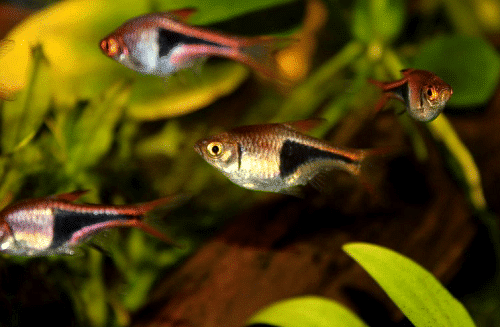
- Scientific Name: Trigonostigma heteromorpha
- Adult Size: 2 inches
- Minimum tank size: 15 gallons
- Compatibility: High
- Care Level: Easy
- Water Temperature: 72-77°F
- Diet: Omnivore
- Origin: Southeast Asia
- Swimming Level: Middle
Harlequin rasboras are easy to recognize by the distinctive black triangle on their sides. The rest of their body is golden orange, which makes these little fish really stand out in an aquarium. Harlequin rasboras are a great choice for a planted betta tank.
4. Cardinal Tetra

- Scientific Name: Paracheirodon axelrodi
- Adult Size: 1.5 inches
- Minimum tank size: 15 gallons
- Compatibility: High
- Care Level: Moderate
- Water Temperature: 73-84°F
- Diet: Omnivore
- Origin: Venezuela & Brazil
- Swimming Level: Middle, top
Cardinal tetras are one of the most brightly colored fish in the aquarium hobby. These nano schooling fish can make amazing tank companions if kept in schools of 6 or more.
Cardinal tetras grow a little larger and are a little more difficult to care for than the more common neon tetras.
5. Neon Tetra
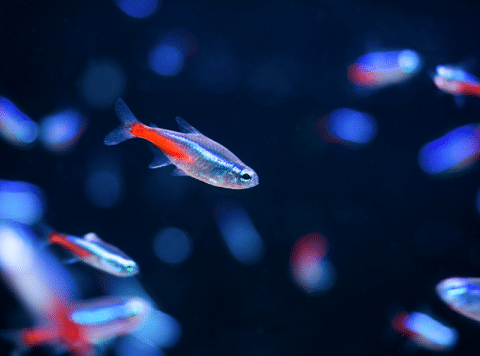
- Scientific Name: Paracheirodon innesi
- Adult Size: o.8-1.2 inches
- Minimum tank size: 10 gallons
- Compatibility: High
- Care Level: Easy
- Water Temperature: 70-77°F
- Diet: Omnivore
- Origin: South America
- Swimming Level: Middle
The classic neon tetra is just as well known as the betta, but did you know they make great mates for the tank? That’s right, a school of neon tetras will add amazing color and activity to your betta fish tank. The most important thing to remember is that neon tetras need to be kept in a school to be comfortable.
6. Ember Tetras

- Scientific Name: Hyphessobrycon amandae
- Adult Size: 0.75 inches
- Minimum tank size: 10 gallons
- Compatibility: High
- Care Level: Easy
- Water Temperature: 72-77°F
- Diet: Carnivore
- Origin: Brazil
- Swimming Level: Middle
Ember tetras are another awesome schooling fish that can live with bettas. These tiny fish have an amazing bright orange color that can make any fish tank look amazing.
If you want to brighten up your betta tank, consider picking up a school of 6 or more of these peaceful tetras!
7. Rummy Nose Tetra

- Scientific Name: Petitella spp.
- Adult Size: 2 inches
- Minimum tank size: 20 gallons
- Compatibility: High
- Care Level: Moderate
- Water Temperature: 74-79°F
- Diet: Omnivore
- Origin: Brazil & Peru
- Swimming Level: Middle
Rummy nose tetras are beautiful schooling fish that make suitable companions for both male and female bettas. These distinctive fish have red faces and bold black and white tails.
Rummynose tetras need higher water quality and a larger tank than some other fish, so they are a better choice for more experienced fish keepers.
8. Molly Fish
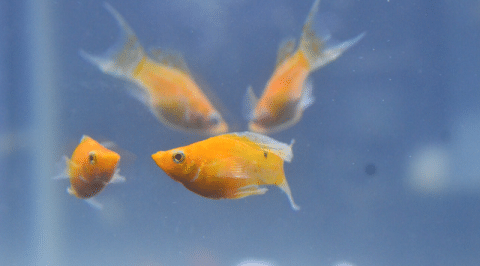
- Scientific Name: Poecilia latipinna, P. spenops, P. velifera
- Adult Size: 5 inches
- Minimum tank size: 15 gallons
- Compatibility: Medium, requires hard water
- Care Level: Moderate
- Water Temperature: 72-82°F
- Diet: Omnivore
- Origin: North & South America
- Swimming Level: Middle
Molly fish are medium-sized livebearers that come in all sorts of shapes and sizes and colors. These peaceful fish species make awesome tank mates, but only if you have naturally hard water.
Molly fish (like platyfish, and guppies) are livebearers. This means they give birth to live young. If you have a male and a female livebearer in the same tank, they can multiply pretty fast. The adult fish (and your betta) will eat these fry, but if you’d prefer your fish to not breed, choose just males or females.
9. Endler’s Livebearers
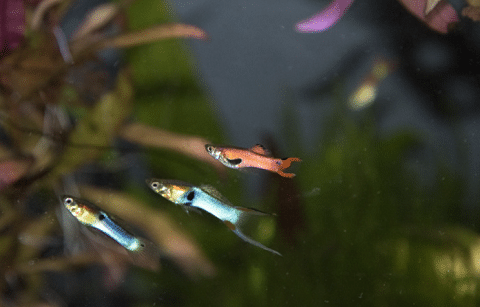
- Scientific Name: Poecilia wingei
- Adult Size: 1 inch
- Minimum tank size: 10 gallons
- Compatibility: Medium, prefers hard water
- Care Level: Easy
- Water Temperature: 64-82°F
- Diet: Omnivore
- Origin: Venezuela
- Swimming Level: All levels
Endler’s livebearers are one of the best choices if you want tank companions for your betta but don’t have a lot of room. Endler’s livebearers stay really small and can be kept in as little as a 10-gallon tank. These fun little fish are super peaceful, and really colorful too!
10. Honey Gourami
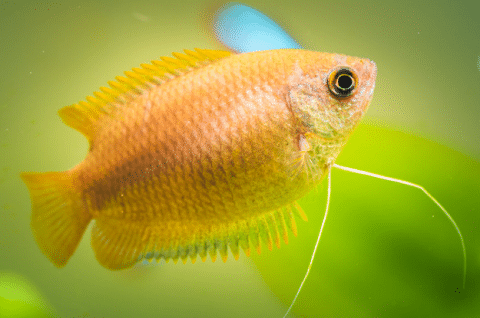
- Scientific Name: Trichogaster chuna
- Adult Size: 2 inches
- Minimum tank size: 20 gallons
- Compatibility: Medium, chance of conflict in small tanks
- Care Level: Easy
- Water Temperature: 72-80°F
- Diet: Carnivore
- Origin: India, Bangladesh, Nepal
- Swimming Level: All levels
The honey gourami is a wonderful community fish that is very peaceful. They are easy to care for and have great colors too. Honey gouramis get along great with betta fish provided they all have enough room.
As a side note, avoid larger gouramis. Honey gouramis are considered passive. Other types can be risky!
11. Chili Rasbora
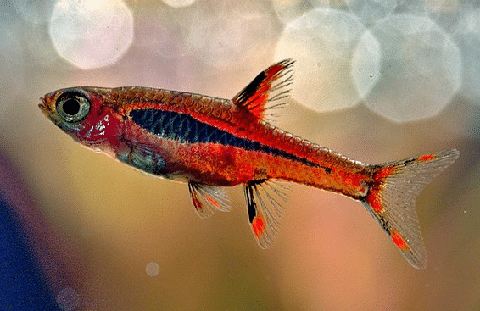
- Scientific Name: Boraras brigittae
- Adult Size: 0.75 inches
- Minimum tank size: 5 gallons
- Compatibility: High, great for nano tanks
- Care Level: Moderate
- Water Temperature: 70-82°F
- Diet: Carnivore
- Origin: Borneo
- Swimming Level: Midwater
If you keep your betta in a nano tank of 5 gallons or so, companions can be pretty tough to find. The chili rasbora is a tiny species that feels right at home in a small tank, and these fish can live happily with one betta fish in a small tank.
These schooling fish should always be kept in groups, or they will tend to be very shy. A betta fish and a school of chili rasboras in a heavily planted nano tank makes for a great display!
12. Otocinclus
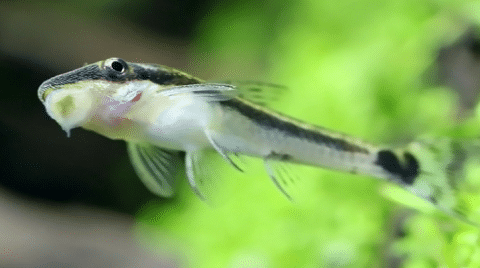
- Scientific Name: Otocinclus spp.
- Adult Size: 2 inches
- Minimum tank size: 10 gallons
- Compatibility: High, great clean-up crew
- Care Level: Moderate
- Water Temperature: 74-79°F
- Diet: Algae
- Origin: South America
- Swimming Level: All levels
Otocinclus catfish are one of the best betta tank mates. They grow to just 2 inches or so, but they have a big appetite for algae! These fascinating suckerfish are the perfect algae eaters for mature aquariums.
These fish should not be added to very small, new aquariums because there just won’t be enough food for them. You also want to actually feed them as they tend to do their job well, then starve from not having enough food!
Otos are probably the most peaceful aquarium fish in the entire hobby, so there’s no chance of them harming your betta fish.
13. Bristle Nose Pleco

- Scientific Name: Ancistrus spp.
- Adult Size: 5 inches
- Minimum tank size: 15 gallons
- Compatibility: High
- Care Level: Moderate
- Water Temperature: 70-78°F
- Diet: Herbivore
- Origin: South America
- Swimming Level: Bottom
Bristlenose plecos are great betta fish mates that stay pretty small and do a great job of keeping the bottom of your tank clean. These odd-looking catfish love to graze on driftwood, and they also need some hiding spaces where they can hang out and relax.
Bristle nose plecos are really strange-looking fish, but they won’t bother your betta fish. Like bettas, you should keep just one fish of this kind in the tank to avoid fighting.
14. Kuhli Loach

- Scientific Name: Pangio semicincta
- Adult Size: 4 inches
- Minimum tank size: 15 gallons
- Compatibility: High, no risk of conflict
- Care Level: Easy
- Water Temperature: 70-79°F
- Diet: Omnivore
- Origin: Southeast Asia
- Swimming Level: Bottom
Kuhli loaches are great little fish. They’re really peaceful, look amazing, and are great for cleaning up uneaten food from the bottom of the tank.
These eel-like fish will get along great with your betta fish! The only downside to kuhli loaches is that they are a little shy, and tend to spend a lot of time hiding out in the substrate and under decorations or hardscape.
15. Bamboo Shrimp
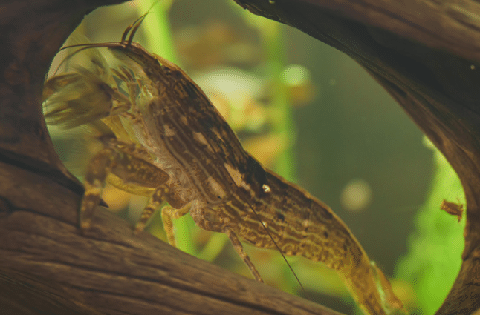
- Scientific Name: Atyopsis Mollucensis
- Adult Size: 2 inches
- Minimum tank size: 20 gallons
- Compatibility: High
- Care Level: Moderate
- Water Temperature: 68-77°F
- Diet: Filter feeder
- Origin: Southeast Asia
- Swimming Level: Bottom dweller
Unfortunately, bettas love to snack on small shrimp species like cherry and crystal shrimp. There is one shrimp that does great with bettas, however, the bamboo shrimp! These fascinating filter feeders are too big for your betta to bother or eat, so they make great male and female betta tank companions.
Fish To Avoid
There are many great tank mates for betta fish out there, but there are also a few to steer clear of! Let’s take a look at some betta fish companions you’ll want to avoid.
1. Tiger Barbs
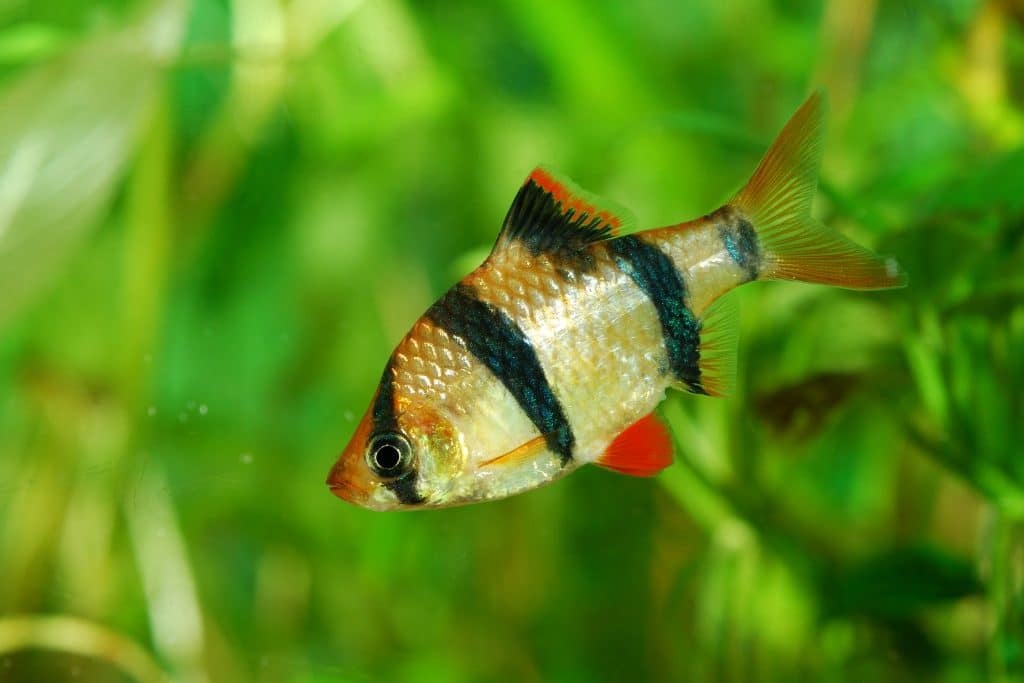
Tiger barbs might be beautiful, but they tend to be a little too boisterous to make good mates for bettas. These colorful fish also have a reputation for fin-nipping, which is why they can be such a threat to the male betta with its long, flowing fins. This is one barb fish you should definitely keep out of your betta tank!
2. Cichlids
Most cichlid species will not make good mates for your betta. These fish tend to be pretty territorial, and the larger species can be very predatory too. There are some cichlids like rams that could make potential tank companions for bettas but even they would be risky.
3. Angelfish
Angelfish are a really beautiful tropical fish species. They are happy in the same water conditions as your betta too, so what’s the problem?
Unfortunately, bettas and angelfish have been known to fight. It could be because they have similar body shapes. To be on the safe side, avoid keeping angelfish as betta tank companions.
4. Goldfish
Goldfish are coldwater fish that need a water temperature of 65-72°F to really thrive. Bettas like it much warmer at 76-81°F, so the problem with these two tank mates is pretty obvious!
5. Nippy Tetras
While many tetras can make great betta fish tank mates, some of them just don’t play along. Avoid the following tetra species:
- Serpae tetras
- Black skirt tetras
- Silvertip tetras
Fish Community Aquarium Setup
As you can see, there are loads of awesome betta fish mates to choose from. Before bringing any of these fish homes, however, you’re going to need to make sure your tank setup is ready for them.
Read this section to learn more about setting up a great betta community.
Introducing Companions
Each betta fish has his or her own personality, so it’s really important to have a ‘plan-B’ in case your fish aren’t getting along. A small aquarium that you can use as a hospital tank is the ideal backup plan.
You should also use this tank to quarantine the new fish for about two weeks before you add tank mates to your display tank. Adding some hiding spaces and live plants will also help to break up the line of sight and let your fish get away from any conflict.
The cleanup crew
Believe it or not, there are some aquarium animals that can be really helpful in keeping your aquarium clean.
Here are some examples of clean-up crew animals:
- Nerite snails
- Malaysian trumpet snails
- Mystery snails
- Otocinclus catfish
Horned Nerite Snails are excellent algae eaters for planted tanks.
While all these animals will help to keep your tank clean by feeding on algae, cleaning the substrate, or eating up leftover food, it’s important to never let them go hungry. Remember to feed your clean-up crew a healthy diet in addition to the food they will scavenge in the tank.
Aquarium Size
Many fish keepers keep their betta fish in a five-gallon tank or even less. The fact is that adding more tank mates to such a small tank can be risky. There are options, however, and you could look at adding some small fish like chili rasboras.
If you really want to set up a great community betta tank and add more tank mates, look at upgrading your tank to a 15 or 20-gallon. These are still small tanks but they open up your options to pretty much all of the great betta fish mates on my list.
Heating
Betta fish are tropical fish, and so are all the other fish in this article. Unless you live in a tropical climate, that means you’re going to need a good quality aquarium heater to keep the water temperature in a comfortable range. Your heater is adjustable, so make sure you dial it to the right temperature.
Bettas prefer a temperature of between 76-81°F. If you were to add a school of neon tetras (70-77°F) and a bristle nose pleco (70-78°F) for example, you would need to set your thermometer to about 77°F to keep everyone happy.
Filtration
Quality filtration and maintenance are what keep your fish healthy and your tank looking great. These are two things you just can’t go without!
Picking out the right aquarium filter can be a little intimidating with all the different makes and models available in the hobby, so let’s take a look at a few options:
- The most cost-effective option would be a sponge filter and air pump combination. These work great in small tanks but they do take up a bit of room in the aquarium. Make sure you pick up a decent air pump too because some models can be pretty noisy.
- Internal power filters and hang-on back filters are ideal mid-range filters for a community betta tank. They don’t take up too much room, they’re affordable, and they’re really easy to set up. Here’s an important tip: choose a model with an adjustable flow rate and pay attention to the current it creates, remember, betta males aren’t strong swimmers!
- A small canister filter comes in at a higher price than the other options but has some great benefits. These filters are housed externally, so they are not visible when looking at the aquarium. This style also holds a high volume of filtration media, and you can customize this media to suit your needs.
Maintenance & Testing
Having a great clean-up crew and high-quality filtration will help to keep your betta community tank clean and healthy, but you’ll still need to roll up your sleeves and perform regular tank maintenance.
If you don’t already have a kit, go ahead and pick up a water test kit. These are super important for monitoring your water quality. You’ll want to be able to measure the following parameters:
- pH
- Hardness
- Ammonia
- Nitrite
- Nitrate
It’s very important to know what your pH and water hardness are before planning any aquarium, although there are some things you can do to change them if really necessary.
Ammonia, nitrite, and nitrate, on the other hand, are nitrogen compounds that increase and decrease naturally in fish tanks. If you measure any ammonia or nitrite, your tank has not completely cycled and is not yet ready for a betta fish or any other tank companions.
Nitrate levels naturally rise over time as more fish waste and uneaten food are processed by the beneficial bacteria in your filter. This nitrogen compound is less harmful to your fish and can be allowed to increase to 20 ppm or a little more before you’ll need to perform a water change.
Live Plants
Live plants can turn an average fish tank into an amazing natural underwater world. Aquarium plants also have all sorts of benefits for your fish and even help to keep your water quality high, reducing the amount of maintenance you need to do.
Start with a few easy plants like Java ferns, marimo moss balls, and Anubis if you’re new to growing live plants. These plants don’t need specialized lighting and require very little maintenance.
Hardy, forgiving and easy to grow. The Anubias Nana is your ticket to the incredible hobby that is aquascaping!
Substrate & Decorations
Substrate and decorations mostly come down to your personal preference, but there are a few important tips that I can share:
- Make sure everything you put into your tank is aquarium-safe and designed for fish tank use.
- Wash your substrate carefully before adding it to your tank.
- Most fish feel more comfortable over a darker substrate.
- Bettas love caves and leaf hammocks where they can hang out. Other fish like bristlenose plecos also love hiding spaces, so make sure to provide each tank mate with a comfortable environment.
- Avoid ornaments and other objects with sharp edges that can tear the flowing fins of the male betta.
Fish Companions
The great thing about the betta fish tank mates in this list is that they are common and easy to find at most local pet stores. Buying online is a better option if you don’t have a decent fish store nearby, or just prefer the convenience of having the fish delivered safely to your door.
Do The Fish Need Companions?
Betta fish do not need to live with other fish. Your betta won’t get lonely, but it might get bored if kept in a very small and empty fish tank.
What Fish Can They Live With?
There are many excellent betta fish mates in the aquarium hobby. Certain mates work better than others in a community tank, however. Some of the best tank mates for betta fish include peaceful fish like corydoras and otocinclus catfish, as well other brightly colored fish like ember tetras and rummy nose tetras.
Can Male And female Live Together?
A male betta should not be kept with female bettas in the same tank. Unfortunately, this can lead to serious fighting and even death. Male and female bettas should only be brought together to breed.
Can Guppies Live With Them?
Guppies can live with bettas in a community tank. Guppies prefer higher pH water, however, so they can make ideal mates for betta fish as long as the water pH is neutral or slightly higher. Fancy tail males are also prone to get picked by a male Betta
Final Thoughts
Choosing the best mates for your betta fish can be pretty stressful, especially with the aggressive reputation of these awesome fish. Fortunately, betta fish can get along really well with loads of different fish in carefully planned community tanks. The 15 species in this list are some of the best betta tank mates in the hobby, so you can add them to your community tank with confidence!
Do you love betta fish? Tell us about your favorite tank mates for betta fish in the comments below!
- About the Author
- Latest Posts
I’m thrilled that you found Aquarium Store Depot! Here you’ll find information on fish, aquariums, and all things aquatics related. I’m a hobbyist (being doing this since I was 11) and here to help other hobbyists thrive with their aquariums! I adhere to a high quality Editorial Process and Review products with real life field usage and practical analysis.

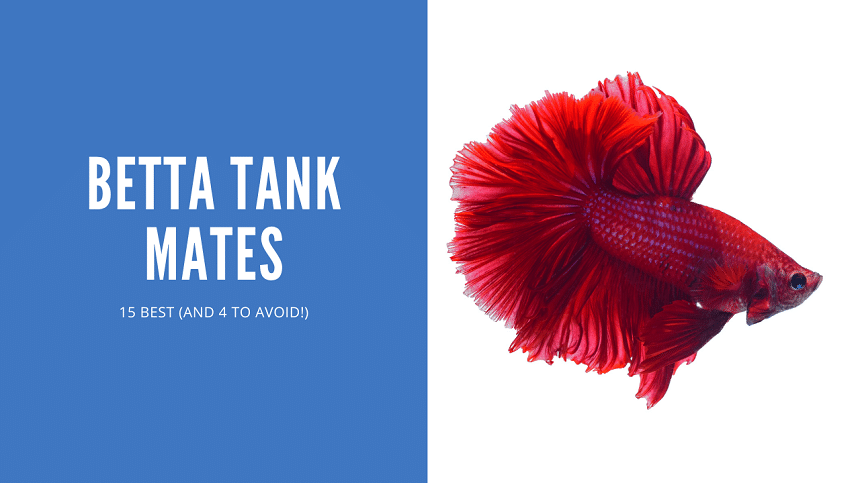






I have a male betta in a 5 gallon tank which is prone to algae growth. I’m looking for a peaceful efficient cleaner as well as a fun to watch (not always hiding) fish. What would you recommend?
For a 5 gallon tank – a mystery snail
I’m pretty excited to be starting my Beta Sorority tank. I only have a blue half-moon named BlueBerry for the moment. How many female Betas can be in a 36g? I’m wanting to add some cherry shrimp and mystery snails as well. What’s your thoughts? I have 4 caves right now and 4 anubis in as well. Will be adding more as the community grows.
Hi there. I would encourage you to check out Lisa at KG Tropicals as she is considered our subject matter expert when it comes to female betta. In summary here is the guidance:
– The ideal female betta count is 5 in a 30″ long tank
– You’ll want 6-8 dither fish to run out to help diffuse aggression
– Planted tanks help A LOT
It’s possible that your bettas will try to eat the cherry shrimp. Consider a bigger shrimp like a bamboo or vampire shrimp instead. No issues with the mystery snail.
love the site I recently acquired me a beautiful male Betta his name is David Bowie n now I know what other friends he can have will update once I figure out who will move in.
i had a 10-gallon community tank with a pleco, a cherry shrimp, a few guppies, and a honey gourami. I moved the guppies and gourami to a shallow paladarium with lots of hiding places, so I thought adding a male betta would be ok and that they would all pick spots, but he bullied the rest of them all around the tank. He especially targeted the gourami.
i moved the betta to the tank with the pleco and shrimp and they are all getting along fine. I’m thinking of adding some neon tetras, but the chili rasboras sound like a good fit, too!
Oh that’s interesting! I love mini gouramis but always thought they wouldn’t get along with a betta. I have a dwarf powder blue one in my daughter’s 20 gallon community tank but was told it wouldn’t do well with a betta. My son currently has a single betta and we will be upgrading to a 20 gallon for him and are doing research on which fish may possibly work. I have no experience with honey gouramis so I’ll look into that one and see if it’s doable.
By chance, did you add the Gourami in with the Betta?
I know It’s only been a few days since you posted the comment.
I’m just curious.
Hi There. The honey gourami is the only gourami that you would have a decent chance with. You will want a larger tank, though. I wouldn’t attempt in an aquarium smaller than 20 gallons.